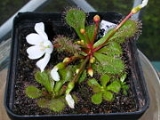
Drosera aberrans
Encyclopedia
Drosera aberrans is a perennial
tuber
ous species in the genus Drosera that is native to New South Wales
, South Australia
, and Victoria
. It grows in a rosette
3 to 5 cm in diameter with green, orange-yellow, or red leaves. It is native to southern inland South Australia, southern and central Victoria, and one single collection from New South Wales. It grows in a variety of soils from sand to laterite
gravel and limestone clay in mallee
woodland, heathland
, and open forests. It flowers from July to September.
It was perhaps first illustrated by Ferdinand von Mueller
in 1879, which he identified as Drosera whitackeri [sic], though Allen Lowrie
and John Godfrey Conran note that this could represent artistic license
and may not have been drawn from an actual specimen. Lowrie and Sherwin Carlquist
first formally described this taxon
in 1992 as a subspecies of Drosera whittakeri
. Lowrie and Conran reviewed the specimens of D. whittakeri in 2008 and elevated subsp. aberrans to species rank based on the colony-forming morphology of this species.
Perennial plant
A perennial plant or simply perennial is a plant that lives for more than two years. The term is often used to differentiate a plant from shorter lived annuals and biennials. The term is sometimes misused by commercial gardeners or horticulturalists to describe only herbaceous perennials...
tuber
Tuber
Tubers are various types of modified plant structures that are enlarged to store nutrients. They are used by plants to survive the winter or dry months and provide energy and nutrients for regrowth during the next growing season and they are a means of asexual reproduction...
ous species in the genus Drosera that is native to New South Wales
New South Wales
New South Wales is a state of :Australia, located in the east of the country. It is bordered by Queensland, Victoria and South Australia to the north, south and west respectively. To the east, the state is bordered by the Tasman Sea, which forms part of the Pacific Ocean. New South Wales...
, South Australia
South Australia
South Australia is a state of Australia in the southern central part of the country. It covers some of the most arid parts of the continent; with a total land area of , it is the fourth largest of Australia's six states and two territories.South Australia shares borders with all of the mainland...
, and Victoria
Victoria (Australia)
Victoria is the second most populous state in Australia. Geographically the smallest mainland state, Victoria is bordered by New South Wales, South Australia, and Tasmania on Boundary Islet to the north, west and south respectively....
. It grows in a rosette
Rosette (botany)
In botany, a rosette is a circular arrangement of leaves, with all the leaves at a single height.Though rosettes usually sit near the soil, their structure is an example of a modified stem.-Function:...
3 to 5 cm in diameter with green, orange-yellow, or red leaves. It is native to southern inland South Australia, southern and central Victoria, and one single collection from New South Wales. It grows in a variety of soils from sand to laterite
Laterite
Laterites are soil types rich in iron and aluminium, formed in hot and wet tropical areas. Nearly all laterites are rusty-red because of iron oxides. They develop by intensive and long-lasting weathering of the underlying parent rock...
gravel and limestone clay in mallee
Mallee Woodlands and Shrublands
Mallee Woodlands and Shrublands is a Major Vegetation Group which occurs in semi-arid areas of southern Australia. The vegetation is dominated by mallee eucalypts which are rarely over 6 metres high...
woodland, heathland
Heath (habitat)
A heath or heathland is a dwarf-shrub habitat found on mainly low quality acidic soils, characterised by open, low growing woody vegetation, often dominated by plants of the Ericaceae. There are some clear differences between heath and moorland...
, and open forests. It flowers from July to September.
It was perhaps first illustrated by Ferdinand von Mueller
Ferdinand von Mueller
Baron Sir Ferdinand Jacob Heinrich von Mueller, KCMG was a German-Australian physician, geographer, and most notably, a botanist.-Early life:...
in 1879, which he identified as Drosera whitackeri [sic], though Allen Lowrie
Allen Lowrie
Allen Lowrie is a West Australian botanist. He is living in Duncraig, a Perth suburb, is married and has two daughters.Lowrie, originally a businessman and inventor, got in contact with the carnivorous flora of western Australia in the late sixties and worked on it as an amateur...
and John Godfrey Conran note that this could represent artistic license
Artistic license
Artistic licence is a colloquial term, sometimes euphemism, used to denote the distortion of fact, alteration of the conventions of grammar or language, or rewording of pre-existing text made by an artist to improve a piece of...
and may not have been drawn from an actual specimen. Lowrie and Sherwin Carlquist
Sherwin Carlquist
Sherwin Carlquist is an American botanist and photographer. He received his undergraduate degree from the University of California, Berkeley in 1952 and a Ph.D. in botany in 1956, also at Berkeley. Carlquist did a postdoctoral study at Harvard University from 1955 to 1956. After his postdoctoral...
first formally described this taxon
Taxon
|thumb|270px|[[African elephants]] form a widely-accepted taxon, the [[genus]] LoxodontaA taxon is a group of organisms, which a taxonomist adjudges to be a unit. Usually a taxon is given a name and a rank, although neither is a requirement...
in 1992 as a subspecies of Drosera whittakeri
Drosera whittakeri
Drosera whittakeri is a sundew that is native to South Australia.-Description:Plants are 4 to 8 cm in diameter, with broadly spathulate leaves arranged in a rosette. These may be green, orange-yellow or red in colour and are 10 to 15 mm long and 9 to 13 mm wide...
. Lowrie and Conran reviewed the specimens of D. whittakeri in 2008 and elevated subsp. aberrans to species rank based on the colony-forming morphology of this species.

